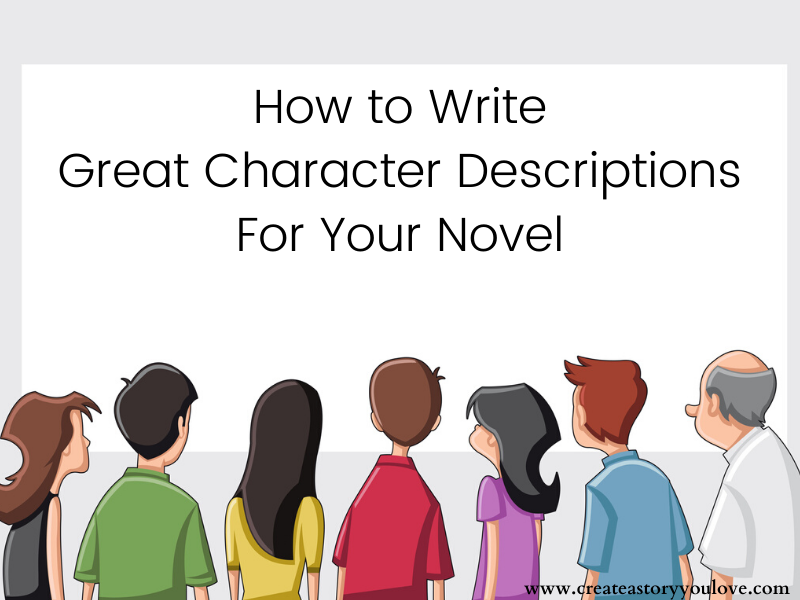As a fiction author, you want readers to fall in love with your characters.
You want readers to be unable to putdown your book as they fly to the end.
Characters that are compelling to your readers, are memorable. When you write characters who become real and grow into friends for your readers, they will relate to and grow to love them. That’s pretty amazing, right?
So, how can you as a writer create great descriptions that will make your readers bond with and fall in love with your characters?

Why Creating Real Characters is Necessary for Great Stories
Creating real characters – with real flaws, wounds, personality traits and habits – is necessary for great stories. Otherwise your characters become flat. They come across more like they are 2D poster board cutouts, than real 3D characters.
When the characters you write, seem more like real people, your readers begin to relate to them. Your reader becomes invested in the problems they face, their struggles, their flaws and how your character will overcome each problem they face.
As you give your readers more depth to the characters they read about in your book, you are giving them more to grasp onto.
Often, readers will dig deep into their own past experiences with people they know and it will shed more light as to how they relate to each character you write.
So, what are important details to think about as you create your characters? Below I share some tips that have helped me dig deep and add more depth to each character you write.
3 Ways to Dig Deeper into Who Your Characters Are to Make them Real
1.Personality Traits.
Each of your characters – much like real people – has personality traits. These are aspects of their personality that are either positive or negative and will add or detract from their growth throughout the story.
Characters are striving for growth and to become the best version of themselves.
Positive traits help your character win the day and achieve their goal. Sometimes however, your character might believe his/her strengths as weaknesses.
Some examples of Positive Traits are: Adventurous; Affectionate; Ambitious; Analytical; Cautious; Charming; Confident; Creative; Diplomatic; Decisive; Empathetic; Focused; Honest; Honorable; Independent; Loyal; Kind; Merciful; Playful; Protective; Quirky; Sensible; Trusting, and many more.
Negative traits, hold your character back in some way from their growth and reaching their ideal. Flaws/wounds are your character’s weaknesses. Some are small, while others are big and can really hamper your character’s progress.
Some examples of Negative Traits are: Abrasive; Antisocial; Callous; Childish; Controlling; Cruel; Defensive; Dishonest; Disloyal; Forgetful; Grumpy; Haughty; Hypocritical; Impatient; Impulsive; Manipulative; Know-It-All; Nagging; Nervous; Paranoid; Possessive; Reckless; Scatterbrained; Selfish; Spoiled; Temperamental, and many more.
Helpful Tip: Take a look at the Myers-Briggs personality traits. This website has many examples of personality traits of popular fiction characters.
2.Habits.
Each of your primary and secondary characters will have certain habits that make those characters memorable. It’s important that their habits – whether good or bad – that you give your primary characters or villain, match up with the personality traits you give them.
Some examples of character habits: coffee drinker; nail biter; nose pincher; runs hand through hair; loud talker; heavy smoker; glamorous woman; hair twirler; character who is constantly on their smartphone; scratchy voice, etc.
3.Flaws/Wounds.
Uncovering your characters deepest wounds or flaws, is very important. These come as you delve into your character’s backstory and discover childhood pain or trauma.
This pain or trauma is an emotional wound and your character will have at least one. An emotional wound is a negative experience that causes a lasting hurt that often involves someone close to us: parents, siblings, mentor, friend, or someone we trust.
Like real people, our characters are products of their past and as writers we need to have a intimate knowledge of their past pain/wounds. These wounds change how our characters see themselves, what they believe and what they fear most. These emotional wounds also cause trust issues, damage our character’s self-worth and will often control how they interact with others.
These flaws and wounds often keeps your character trapped in false beliefs. These false beliefs(lies), are destructive and stalls or completely stops the inner growth and happiness of your characters. And it’s only when your characters finally shatters the lies that they will feel they truly deserve the goal they are reaching for.
Some examples of negative events that can cause Emotional Wounds: traumatic brain injury; being held captive; being treated as property; witnessing a murder; speech impediment; living with chronic pain or illness; prejudice or discrimination; accidentally killing someone; being fired or laid off; becoming homeless; failing to save someone’s life; getting dumped; growing up in Foster care, and many more. (for more examples see The Emotional Wound Thesaurus by Angela Ackerman and Becca Puglisi).
When you use each of these 3 ways to learn more about your characters, you will be able to write compelling and very real characters. Readers will then be invested in your characters because in some ways it will feel like they know them.
Writing this way, will make your characters will be memorable.
Then your novel will be unputdownable. 🙂
What steps do you take to write great character description? Please, comment below. We can learn from each other…
